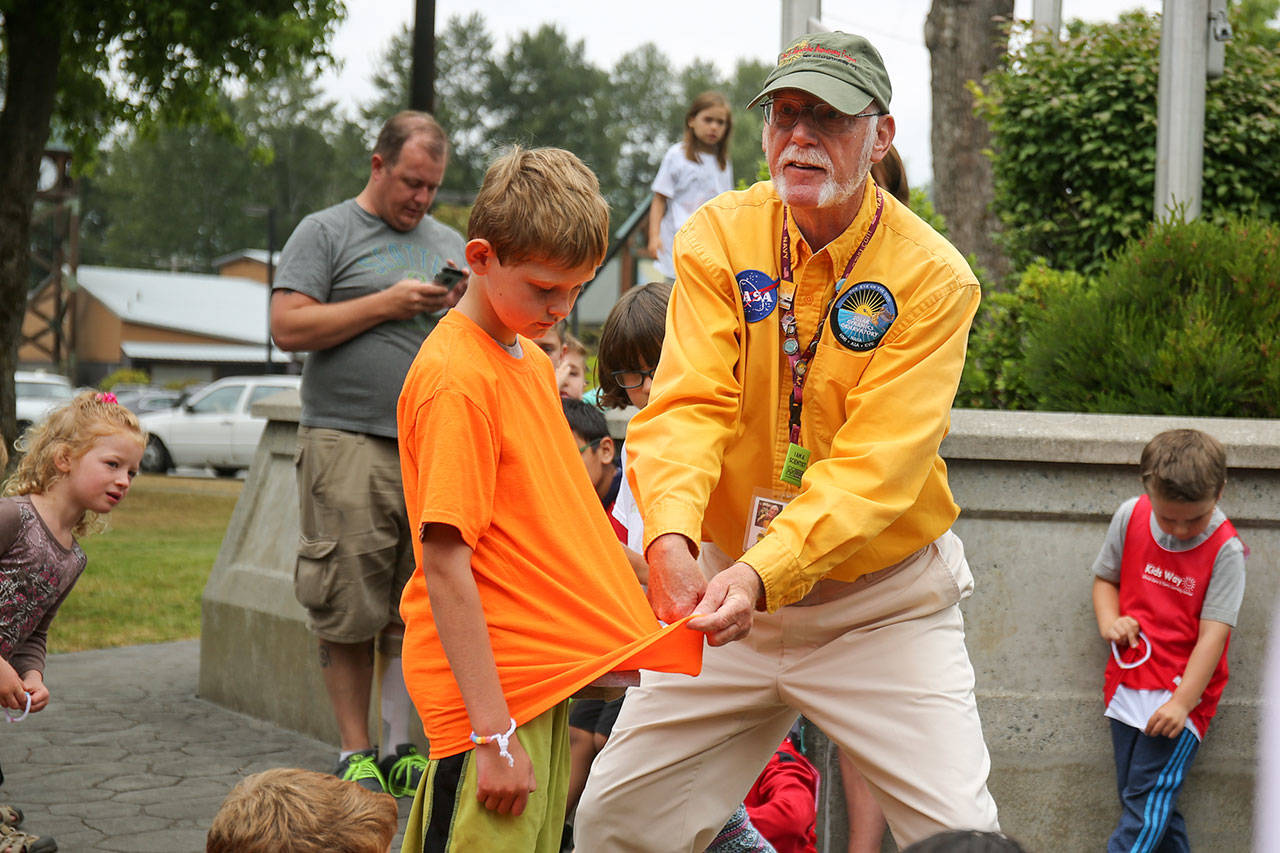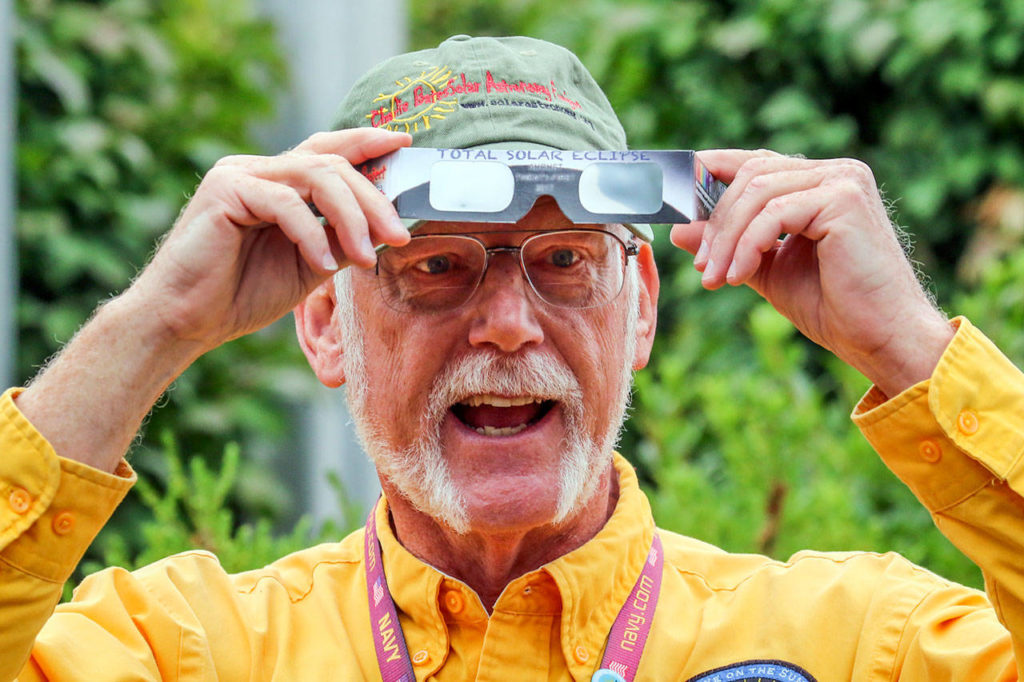The Great American Eclipse is coming to skies near you on Aug. 21 — the first coast-to-coast solar eclipse in 99 years and likely the most hyped ever — but eye doctors and scientists warn not to watch it without proper eye protection.
People have been asking if high-quality sunglasses are OK for viewing an eclipse, said Dr. Bill Church, an Everett-based optometrist, and the answer from him is an emphatic “No! They are not OK!”
If you watch through sunglasses, he said, “You will get a burn that will damage your vision for the rest of your life.”
It’s “eye suicide,” according to www.mreclipse.com, and there’s no going back. “The retina is delicate and irreplaceable,” states the site. “There is little or nothing a retinal surgeon will be able to do to help you.”
Known as solar retinopathy, eye damage from the sun is caused by invisible infrared wavelengths. The damage can be painless and can occur within seconds, even when the moon blocks out 99 percent of the sun, according to NASA’s website at https://eclipse.gsfc.nasa.gov/SEhelp/safety.html.
The only time a solar eclipse is safe to view without eye protection is at totality, projected to last just over two minutes in this eclipse, when the moon covers the sun and only the sun’s corona can be seen. But that won’t happen here. The path of totality lies to the south, in a 60- to 70-mile-wide band stretching from the beach town of Lincoln City, Oregon to the South Carolina shore.
Millions of people are expected to flock to that band of totality, with at least 100,000 alone projected for the town of Madras, Oregon, about two hours from Portland. With its wide-open spaces, high elevation and no light pollution, the town was pinpointed by astronomers as a primary viewing site and is listed as a top 10 site at https://www.greatamericaneclipse.com/best-places-to-view.
What will be seen in the Puget Sound area, weather permitting, is a partial eclipse that should still be quite impressive. The countdown is set to begin at 9:09 a.m. in Everett, with the eclipse reaching its maximum magnitude of 92 percent at 10:21 a.m. and ending at 11:39 a.m., according to https://www.timeanddate.com/eclipse/solar/2017-august-21. Further south in Seattle, the magnitude is projected to be 93 percent.
Staring at the sun with the naked eye can cause damage under any circumstances, but a solar eclipse puts more people at risk. That’s because reflexes that cause a person to blink or look away from the sun might not be triggered.
“With the sun partially covered, it’s comfortable to stare,” writes science writer Stephanie Pappas at https://www.livescience.com/20433-solar-eclipse-blind.html, “and protective reflexes like blinking and pupil contraction are a lot less likely to kick in than on a normal day.”
Though total blindness is fairly rare, people who suffer sun damage are often troubled by spots in their vision. The most famous case, Pappas writes, is that of Sir Isaac Newton, who tried looking at the sun in a mirror, blinded himself for three days and saw sunspots for months afterward. And research suggests that damage that doesn’t repair itself in the first few months may be permanent, as reported in a 1995 study on solar-eclipse viewers in Turkey, where eye damage found 18 months after an eclipse was still evident 15 years later.
Think of the energy able to light paper on fire when focused through a magnifying glass, then imagine that energy on your eye, like “a laser beam on your retina,” said retired scientist Roger Kennedy, at a solar education event last month at the Lynnwood Library.
So how can people safely look at the solar eclipse? Wear solar-eclipse glasses with lenses of aluminized mylar.
“You can’t see anything but the sun when you’re wearing solar glasses,” Kennedy said, likening them to “wearing a seat belt” to keep the eyes safe.
He cautioned that children younger than 5 should not be allowed to view the eclipse. They are too young to understand the importance of keeping the glasses on, he said, and might peek and damage their eyes.
Welding glasses, shade 14 and above, as well as special solar filters for telescopes, binoculars and cameras are also safe to use, he said. And one of the safest strategies is to view the eclipse indirectly, such as with a makeshift pinhole camera that projects an image onto the ground or a screen.
Kennedy and his wife, Linda, a retired librarian, partner with NASA to travel around the country from their home in New Mexico to teach about the sun. They visited several Sno-Isle libraries this summer to talk about the eclipse and to let people look at the sun through filtered telescopes. They’ve also been handing out free solar eclipse glasses.
The last of these events is today at 1 p.m. at the Mill Creek Library, 15429 Bothell Everett Highway.
Free solar eclipse glasses have also been available at the Snohomish Library, one of 7,000 libraries in the country to receive some 2 million free glasses and 4,000 education kits as a result of grants and donations to the nonprofit Space Science Institute, according to the STAR Library Education Network.
Snohomish Library is the only library in the Sno-Isle system to get the free solar eclipse glasses, thanks to children’s librarian Kathy Smargiassi. Librarians have been handing out the glasses at a rate of 30 to 40 a day, one to each patron.
Smargiassi said she ordered the glasses following a training session with STAR Net, which is working to bring STEM to libraries, in response to an email the organization sent out. At the time, she had no idea the solar eclipse glasses would be so popular.
“It turned out to be a slightly bigger deal than I thought,” she said.
Excitement is growing as the eclipse date nears, she said, noting that the next solar eclipse due to cross the country is in 2024, but will cross Texas and the East Coast, and won’t come anywhere near the Pacific Northwest.
By July’s end, she estimated there were only about 300 solar eclipse glasses remaining out of the library’s box of 1,000. However, that doesn’t include glasses she’s saving for an Eclipse Day program she’s leading at the Snohomish Library, starting at 9:30 a.m. on Monday, Aug. 21. It’s geared toward children, but Smargiassi said all are welcome. The event will go on regardless of clear skies or clouds.
“If it’s cloudy, my heart will be sad,” she said, “but we’ll still have a program.”
Three other Sno-Isle libraries are also holding Eclipse Day events. They are:
- Camano Island Library, 10 a.m., led by librarians, registration required.
- Mariner Library, 10 a.m., eclipse program led by Managing Librarian Sandra Beck, followed by “Suited for Space” by Museum of Flight staff at 10:30 a.m., registration required.
- Oak Harbor Library, 6:30 p.m., librarians and the Island County Astronomical Society.
Anyone missing out on free glasses can still purchase them from a number of online sites, including Amazon. And Dr. Church, of Everett Optometry Clinic, 3700 Colby Ave., said his clinic is selling solar eclipse glasses for $4 each, to cover the $2 cost plus shipping and handling.
Warning: Some unsafe solar eclipse glasses are being distributed. NASA named five legitimate manufacturers: American Paper Optics, Rainbow Symphony, Thousand Oaks Optical, Baader Planetarium (AstroSolar Silver/Gold film only) and TSE 17.
In addition to the manufacturer’s name, the glasses should also be printed with “ISO” reference number 12312-2. Other NASA tips: If lenses have scratches, are wrinkled or are more than three years old, they are considered unsafe and should not be used. More information can be found at https://eclipse2017.nasa.gov.
If it’s cloudy, or if Puget Sound residents simply want a more up-close and personal view without having to brave the projected huge crowds and traffic jams, NASA will be live-streaming the eclipse from different locations for four hours as it crosses the United States, at https://www.nasa.gov/eclipselive.
Sno-Isle Libraries has also created an eclipse resource page, which includes suggestions on reading materials and links to videos, as well as to an eclipse livestream.
5 essential eclipse facts
With the first U.S.-visible solar eclipse in 38 years coming up on Aug. 21, here are five facts to nerd out with in honor of this historic event.
1. The sun will put a ring on it. In the last few seconds before the eclipse, sunlight streaming through the moon’s valleys creates a bright flash of light on the side of the moon known as the “diamond ring effect.”
2. Corona isn’t just a drink. That glowing light halo around the dark solar eclipse has a name —it’s the “corona,” described by NASA as “the sun’s tenuous atmosphere.”
3. The seven-year itch is real. The last solar eclipse on the West Coast occurred 38 years ago, so you don’t want to miss this opportunity. If you miss this eclipse, you’ll have to wait until April 8, 2024, for the next one. It will carve a path from Maine to Texas. The 2017 eclipse will run from South Carolina to Oregon.
4. Our planets go the distance. The Earth, moon, and sun are currently perfect distances from each other, meaning we can see the corona during this eclipse. Millions of years ago, it was blocked. And millions of years in the future, total eclipses won’t be possible because the moon will appear smaller than the sun.
5. “Greece” is the word. The earliest predicted solar eclipse was in Ancient Greece in 585 BC. It was seen as an omen — one that caused a long-standing battle between the Medes and the Lydians to finally end.
For more on each of these facts, visit https://www.hipcamp.com/journal/guides/how-to-plan-a-2017-eclipse-camping-trip.
Looking for a campsite in the path of totality?
Lodging and camping in the path of totality has been booked for months, and prices can be sky high. To make eclipse-viewing available to all, Hipcamp has been partnering with landowners to create new campsites in the eclipse path — over 1,300 new campsites popped up on Hipcamp in Oregon alone last month.
Hipcamp has compiled the best available map of all camping options for viewing the total eclipse. The best part? Most of the new campsites are on land previously inaccessible to the public and waiting to be explored. See the map here: https://www.hipcamp.com/discover/eclipse-2017
Source: Hipcamp
Talk to us
> Give us your news tips.
> Send us a letter to the editor.
> More Herald contact information.


























